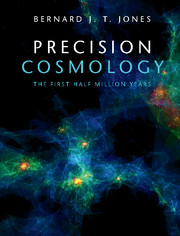Book contents
- Frontmatter
- Dedication
- Contents
- Preface
- Notation and Conventions
- Part I 100 Years of Cosmology
- Part II Newtonian Cosmology
- Part III Relativistic Cosmology
- Part IV The Physics of Matter and Radiation
- Part V Precision Tools for Precision Cosmology
- 23 Likelihood
- 24 Frequentist Hypothesis Testing
- 25 Statistical Inference: Bayesian
- 26 CMB Data Processing
- 27 Parameterising the Universe
- 28 Precision Cosmology
- 29 Epilogue
- Appendix A SI, CGS and Planck Units
- Appendix B Magnitudes and Distances
- Appendix C Representing Vectors and Tensors
- Appendix D The Electromagnetic Field
- Appendix E Statistical Distributions
- Appendix F Functions on a Sphere
- Appendix G Acknowledgements
- References
- Index
26 - CMB Data Processing
from Part V - Precision Tools for Precision Cosmology
Published online by Cambridge University Press: 04 May 2017
- Frontmatter
- Dedication
- Contents
- Preface
- Notation and Conventions
- Part I 100 Years of Cosmology
- Part II Newtonian Cosmology
- Part III Relativistic Cosmology
- Part IV The Physics of Matter and Radiation
- Part V Precision Tools for Precision Cosmology
- 23 Likelihood
- 24 Frequentist Hypothesis Testing
- 25 Statistical Inference: Bayesian
- 26 CMB Data Processing
- 27 Parameterising the Universe
- 28 Precision Cosmology
- 29 Epilogue
- Appendix A SI, CGS and Planck Units
- Appendix B Magnitudes and Distances
- Appendix C Representing Vectors and Tensors
- Appendix D The Electromagnetic Field
- Appendix E Statistical Distributions
- Appendix F Functions on a Sphere
- Appendix G Acknowledgements
- References
- Index
Summary
The CMB data comes from many different kinds of experiment, and in the competition between the small balloon-based missions and huge satellite-borne programs it is occasionally the former who win. But in the end, the high quality sky-wide data comes from space experiments. During this century, two have dominated cosmology so far: WMAP and Planck.
In this chapter we describe how the data is acquired, how it is stored in special format maps, and how it is treated to remove all the non-cosmological contributions. After this has been done we have our data, but it is the need to remove noise and foreground contamination that is the most challenging, and the most demanding of computing resources.
We treat the problem of noise and foreground removal in as generic a way as possible, there is not a single best way of doing this. The mathematical formalism is quite complex, as is the statistical data analysis that will follow.
Introduction
Some of the history of the observations of the Cosmic Microwave Background radiation (CMB) has been recounted in the first part of this book (see Chapter 3). The culmination of the early efforts, the ‘first 30 years’, was perhaps the COBE DMR/FIRAS mission. COBE DMR produced the first all-sky maps of the CMB (Smoot et al., 1991), while the FIRAS experiment on the same satellite had established the remarkable accuracy of the Planckian form of the radiation spectrum (Mather and the COBE collaboration, 1990). Importantly, COBE had delivered a low resolution, albeit noisy, picture of the microwave sky that not only made substantial scientific advances, but also attracted widespread public attention and provided a vital scientific stimulus.
The manifest success of the COBE mission inspired a series of ground-based, balloon-based and and space observatories to look at the fluctuations with more sensitivity and at higher angular resolution. Satellite experiments are expensive and take a long time to build and so the competition to get the key results from lower cost ground based experiments before the space experiments could deliver was fierce, and in large part successful.
- Type
- Chapter
- Information
- Precision CosmologyThe First Half Million Years, pp. 606 - 633Publisher: Cambridge University PressPrint publication year: 2017



